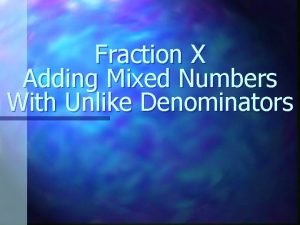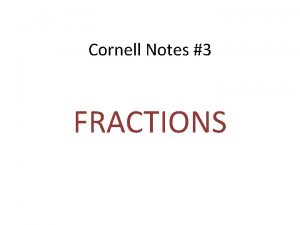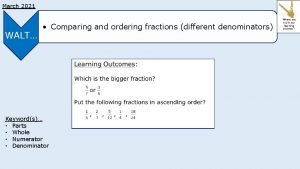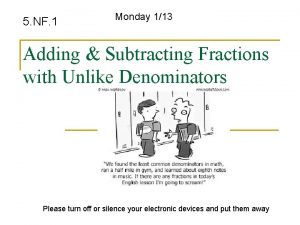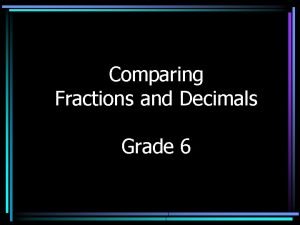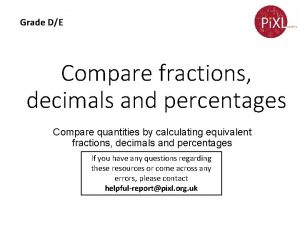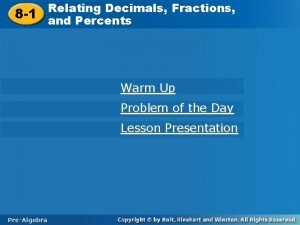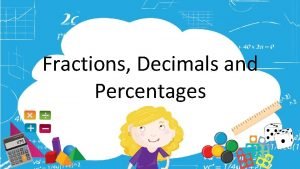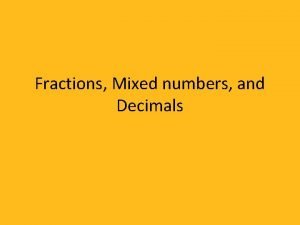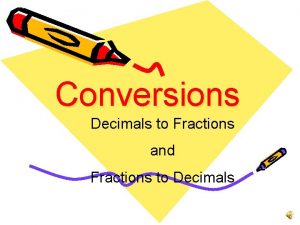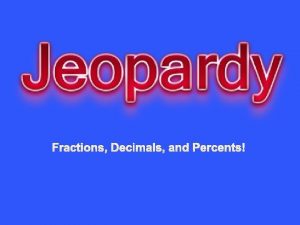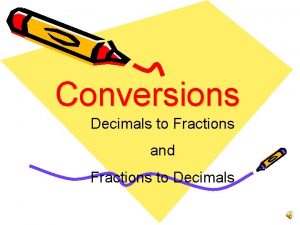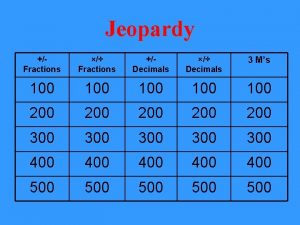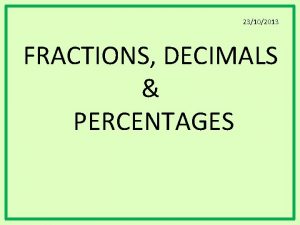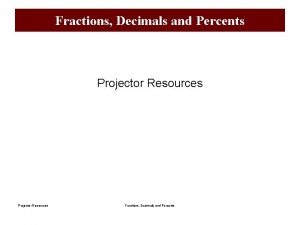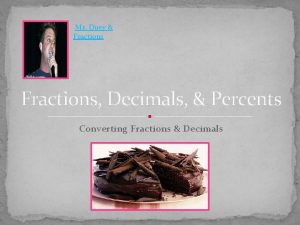Fractions With Like Denominators Terminology Like decimals fractions











- Slides: 11

Fractions With Like Denominators

Terminology Like decimals, fractions represent parts of numbers. A fraction is usually a number that is between 0 and 1. Numerator - number on top Denominator - number on bottom

To add or subtract fractions with like denominators: • If the denominators are already the same, then you’re ready to add or subtract. • Add or subtract the numerators. Keep the denominators the same. • Simplify (reduce) the fraction, if possible. • If you end up with an improper fraction, change it to a mixed number.

Adding and Subtracting Fractions with like Denominators You know that the bottom number of a fraction tells how may parts each whole is divided into. In this picture each circle is divided into 4 parts so the bottom number for this fractions is 4. 4 We use or shade 5 parts so the top number of this fraction is 5. The picture shows the fraction 5. 4 In a fraction the bottom number has a special name. The bottom number in a fraction is called the denominator. The denominator or the bottom number in a fraction tells how many parts each whole is divided into.

What are the denominators in these fractions? Two Six Eight Five Three Remember the bottom number in a fraction is called the denominator.

You have learned to add fractions using pictures. = + 3 + 1 4 3 = 5 3 Fractions can be added and subtracted without using pictures. When you add and subtract fractions you do not work on the top and the bottom the same way.

When you add and subtract fractions you COPY the denominator, then you work on the top. Remember, you copy the denominator and then you work on the top. + 5 4 3 4 = Look at this problem. What is the denominator? Yes, it’s 4. What do you do with the denominator? You copy it in the answer so the denominator in the answer is 4. 4 Now we can add the numbers on the top. What do we get when we add 5 + 3? 5 + 3 = 8. We put the 8 on top in the answer so 5 + 3 = 8. 4 4 4

Examples 1 5 + 2 5 = This answer cannot be reduced any further. 3 5

9 14 5 = 4 ÷ 22 = 2 14 14 7 The GCF of 4 and 14 is 2, so we divide by 2 to reduce.

8 3 + 9 9 11 = 9 This is an improper fraction (the top is bigger than the bottom), so we want to change it to a mixed number. To do this, divide the bottom into the top. 1 9 11 9 2 Answer: 1 2 9

7 12 Try Some 5 1 = 6 12 4 1 5 + = 7 7 7 8 + 12 = 15 15 1 1 3
 How to add mixed numbers with different denominators
How to add mixed numbers with different denominators How to multiply fractions with different denominators
How to multiply fractions with different denominators Adding and subtracting fractions guided notes
Adding and subtracting fractions guided notes Putting fractions in order
Putting fractions in order Brainpop adding fractions
Brainpop adding fractions Compare fractions and decimals
Compare fractions and decimals Compare fractions decimals and percentages
Compare fractions decimals and percentages Relating decimals to fractions
Relating decimals to fractions Where do we see percentages in everyday life
Where do we see percentages in everyday life What is 75/4 as a mixed number
What is 75/4 as a mixed number Convert fraction to decimal
Convert fraction to decimal Order positive and negative integers decimals and fractions
Order positive and negative integers decimals and fractions
